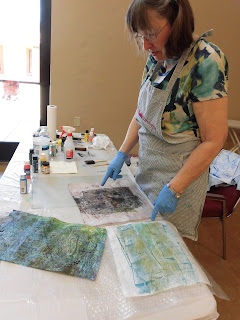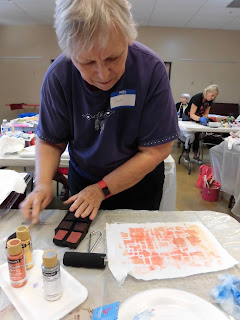Here are the workshops I'm offering at my house this summer. YOU get to suggest the dates of the workshop you want to take! Just contact (jgould1526@gmail.com) me to give me an idea what dates would work for YOU. Workshops during the week or weekend are fine from June through August (and possibly in September). I'm excited about the workshops and look forward to hearing from you.
DYEING FOR BLUE: INDIGO DYEING WITH SHIBORI TECHNIQUES
The seemingly mysterious dye, INDIGO, used throughout the world but famous for its special development in Japan, dyes BLUE ---- from light to darkest of navy. When combined with the Japanese technique of SHIBORI (stitch and bound resists), the two create delightful patterning on natural fabrics (cotton, linen, rayon, silk, wool). Further combined with already colored fabric, multiple colors can be achieved. Students will have their own indigo pot, learn about the history and use of indigo around the world while stitching their fabric, and develop a basic library of stitches in order to design pieces using shibori. Fabric, yarn, and small pieces of clothing (shirts/blouses, thin fabric dresses, small jackets, scarves) can be dyed. A supply list will be sent upon paid registration. Two days. $200 plus $12 for materials.
MONOPRINTING
Using a plexiglass plate and textile paint to explore surface design techniques, students experiment with an unending process to create exciting patterns both amorphous and detailed. These printed fabrics are wonderful for quilting, embroidery, dollmaking and more. A supply list will be sent upon paid registration. One day. $100 plus $5 for materials.
CONTEMPORARY EMBROIDERY
For those with an adventuresome spirit but looking to work in a slower, more contemplative textile method, students will use textile paints to print and paint fabric with images of their own design. These images will create pattern, areas of color, or designs that inspire students to put hand stitching onto the fabric —anything goes! During the afternoon and the next two days the “stitched mark” or one’s own personal stitch vocabulary will be discussed and used on fabric to create rhythm, movement, and visual and physical texture. This workshop will strive to have students look at stitching on fabric, not as decorative, but as an expression of themselves---pulling something new and different from inside onto the cloth. Jennifer will have many samples of her own embroidered pieces, images of contemporary embroiderers’ work from around the world, and books on hand. A supply list will be sent upon paid registration. Two days. $200 plus $15 materials fee.
DISPERSE DYES: Transfer Prints for Synthetic Fabrics
A whole new world awaits you with synthetic fabrics printed with disperse dyes. Everything from polyester organza, iridescent sheers, acetate muslin, synthetic knits and more can be used. Transfer prints made with the dyes create fascinating patterning which can be layered for multiple color overlays especially on sheer fabric. We'll cover exciting possibilities such as basic painting techniques to make transfer prints, manipulating fabric and steaming pleats in place while printing color, using laser copies to print photographic images, using resists to create patterning (such as leaves, lace), and discharge. A supply list will be sent upon paid registration. Two days. $200 plus $15 for materials.
MAKING YOUR OWN STAMPS AND STENCILS
Your own handmade stamps, stencils and rubbing plates give you the most exciting patterning. We'll use rubber insulation foam, polystyrene plates and many other unusual but easily available items. These produce patterning that's personal and never seen before in commercial products. On the second day, students will use textile paints to sample their stamps and stencils. A supply list will be sent upon paid registration. Two days. $200 plus $20 for materials.
SURFACE DESIGN ON FABRIC
Explore the world of surface design techniques through guided demonstrations and your own experiments with textile paint on any type of textile. Flour paste resists, a unique and easy airbrush technique and use of all of my handmade stamps and stencils give students time and opportunity to experiment. A supply list will be sent upon paid registration. Two days. $200 plus $15 for materials.
Look forward to hearing from you!! at jgould1526@gmail.com




































